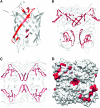Novel internal regions of fluorescent proteins undergo divergent evolutionary patterns
- PMID: 19770223
- PMCID: PMC2775108
- DOI: 10.1093/molbev/msp194
Novel internal regions of fluorescent proteins undergo divergent evolutionary patterns
Abstract
Over the past decade, fluorescent proteins (FPs) have become ubiquitous tools in biological research. Yet, little is known about the natural function or evolution of this superfamily of proteins that originate from marine organisms. Using molecular phylogenetic analyses of 102 naturally occurring cyan fluorescent proteins, green fluorescent proteins, red fluorescent proteins, as well as the nonfluorescent (purple-blue) protein sequences (including new FPs from Lizard Island, Australia) derived from organisms with known geographic origin, we show that FPs consist of two distinct and novel regions that have evolved under opposite and sharply divergent evolutionary pressures. A central region is highly conserved, and although it contains the residues that form the chromophore, its evolution does not track with fluorescent color and evolves independently from the rest of the protein. By contrast, the regions enclosing this central region are under strong positive selection pressure to vary its sequence and yet segregate well with fluorescence color emission. We did not find a significant correlation between geographic location of the organism from which the FP was isolated and molecular evolution of the protein. These results define for the first time two distinct regions based on evolution for this highly compact protein. The findings have implications for more sophisticated bioengineering of this molecule as well as studies directed toward understanding the natural function of FPs.
Figures






References
-
- Chalfie M, Tu Y, Euskirchen G, Ward WW, Prasher DC. Green fluorescent protein as a marker for gene expression. Science. 1994;263:802–805. - PubMed
-
- Field SF, Bulina MY, Kelmanson IV, Bielawski JP, Matz MV. Adaptive evolution of multicolored fluorescent proteins in reef-building corals. J Mol Evol. 2006;62:U3, 32–U315. - PubMed
Publication types
MeSH terms
Substances
Grants and funding
LinkOut - more resources
Full Text Sources
Other Literature Sources
Miscellaneous

